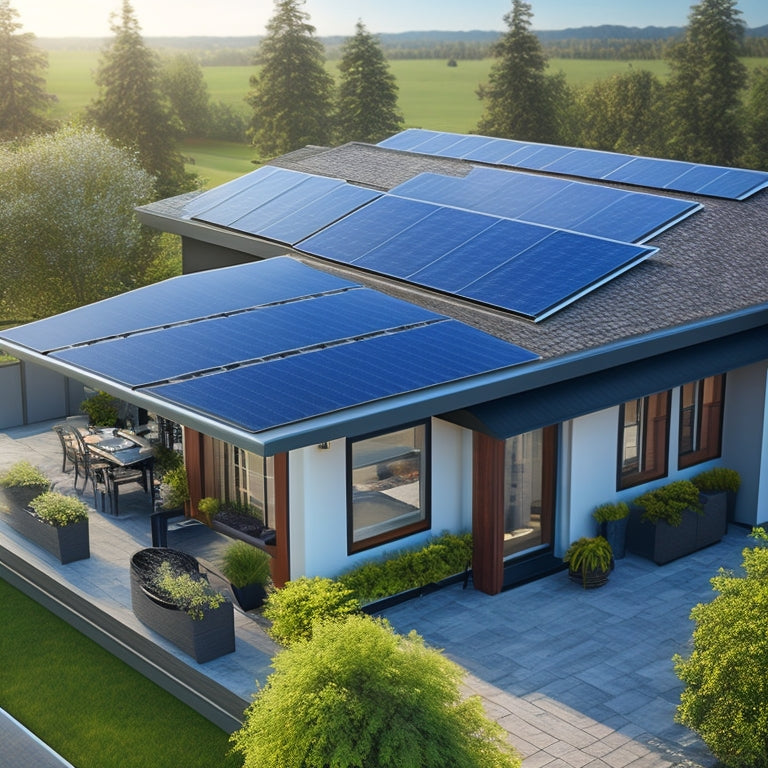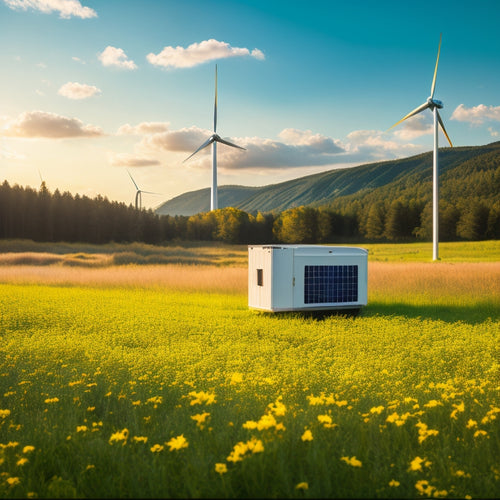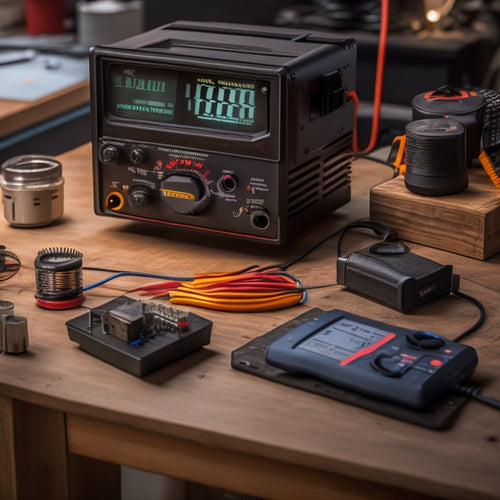
Solar Panel System Installation
Share
When installing a solar panel system, you'll want to maximize energy production and savings. Government incentives, like the Solar Investment Tax Credit, can considerably reduce installation costs. Properly sizing your system and optimizing energy harvesting through techniques like Maximum Power Point Tracking (MPPT) are essential for long-term savings. Evaluating your roof's shading patterns, considering advanced cell technologies like bifacial cells, and optimizing panel placement will also impact your system's performance. As you maneuver through the installation process, understanding these key factors will help you make informed decisions - and there's even more to investigate to guarantee you're getting the most out of your solar panel system.
The Essentials
- Government incentives, such as tax credits and rebates, significantly reduce solar panel installation costs and enhance overall savings.
- Properly sized solar panel systems can lead to nearly zero energy bills and significant reductions in energy expenses.
- Maximum Power Point Tracking (MPPT) optimizes energy harvesting in shading conditions, ensuring maximum output and long-term savings.
- A thorough roof shading assessment is crucial to identify obstructions and optimize solar panel placement for maximum energy production.
- Advanced cell technology, such as bifacial and tandem cells, increases power output per unit area, enhancing overall solar energy production.
Government Incentives Boost Savings
You're likely to save even more on your solar panel installation costs thanks to government incentives.
As you shift to a clean and renewable source of energy, you'll want to understand how tax credits work, as they can greatly reduce your taxable income.
Additionally, you'll need to investigate federal rebate options, which can provide a direct refund on your installation expenses.
Tax Credits Explained
As you consider investing in solar panels, tax credits are an important aspect to understand, as they can greatly impact your overall savings. The good news is that you may be eligible for state and federal tax credits, which can greatly reduce your solar panel system installation costs.
By integrating a battery storage system into your solar setup, you can access the full potential of renewable energy and create a more sustainable, dependable, and cost-effective power solution Energy Storage Solutions.
To determine your tax credit eligibility, you'll need to review the specific incentives offered by your state. Some states provide additional state-specific incentives, such as rebates, tax exemptions, or property tax abatements, which can further reduce your costs. For instance, California offers a property tax exemption for solar panel installations, while New York provides a rebate of up to $1.25 per watt for residential solar panel systems.
It's important to understand the tax credit eligibility requirements, including the system's installation date, system size, and your income level. You'll also need to keep accurate records of your installation costs, as these will be required to claim the tax credits.
Federal Rebate Options
Beyond state-specific incentives, federal rebate options offer considerable savings for homeowners investing in solar panel systems. As you investigate federal programs, you'll find that the Solar Investment Tax Credit (ITC) is a key benefit. This credit allows you to claim a percentage of your solar panel system's cost as a credit against your federal income taxes.
By switching to renewable energy solutions like solar power systems, homeowners can reduce their reliance on grid electricity and lower their energy bills. Solar Energy Solutions
Currently, the ITC provides a 26% tax credit for qualified solar panel systems. To meet rebate eligibility, your system must be installed and operational by December 31 of the tax year in which you're claiming the credit.
Additionally, you must own the system and have it installed on a primary or secondary residence in the United States. It's crucial to keep records of your system's installation, including receipts and certification documents, as you'll need these to claim the credit on your tax return.
Zero Energy Bills Guaranteed
By installing solar panels, you'll achieve energy independence guaranteed, as your system generates electricity that powers your home, reducing your reliance on the grid and utilizing renewable energy.
This shift to renewable energy not only benefits the environment but also provides a sustainable solution for your energy needs.
You'll enjoy zero utility costs, freeing up your budget for more important things.
With a properly sized and installed system, you can say goodbye to monthly energy bills and hello to long-term savings.
Energy Independence Guaranteed
With a solar panel installation, you can expect to slash your energy bills to nearly zero, thanks to the abundant free energy provided by the sun. This means you'll be utilizing the power of nature to fuel your daily life, reducing your reliance on the grid and enjoying the freedom that comes with energy independence.
| Benefits | Description |
|---|---|
| Renewable Energy | Generate clean energy from the sun, reducing your carbon footprint and contributing to a sustainable future |
| Energy Storage | Store excess energy generated during the day for use at night or during power outages, guaranteeing a stable supply |
| System Maintenance | Regular checks and maintenance guarantee your system operates at peak levels, maximizing energy production and extending its lifespan |
| Reduced Energy Costs | Enjoy considerably reduced energy bills, providing you with more financial freedom to pursue your passions |
Zero Utility Costs
As you employ the power of nature, you'll notice a significant shift in your energy expenses. With a solar panel system installation, you're no longer reliant on traditional utility companies, and your energy bills will plummet.
In fact, you can say goodbye to those pesky utility bills altogether. As you capture the sun's energy, you'll start to reap the benefits of solar savings. Your system will generate electricity during the day, and any excess energy will be stored in a battery or fed back into the grid.
This means you'll be using free, renewable energy to power your home, reducing your reliance on utility alternatives. With a well-designed solar panel system, you can enjoy zero utility costs, guaranteed.
You'll have complete control over your energy usage, and you'll be free from the constraints of traditional energy providers. No more worrying about rate hikes or surprise bills – you'll be in charge of your energy destiny.
Maximum Power Point Tracking
When you're dealing with solar panels in shading conditions, you'll want to optimize energy harvesting by leveraging Maximum Power Point Tracking (MPPT).
Efficient home or business solar panel setups, renewable energy solutions, can greatly benefit from MPPT.
MPPT guarantees your system operates at its maximum power output, even when partial shading reduces energy production.
MPPT in Shading Conditions
During partial shading conditions, your solar panel system's maximum power point tracking (MPPT) function plays an essential role in enhancing energy harvest. Shading impact on your solar panels can considerably reduce energy output, but MPPT helps alleviate this effect by continuously monitoring and adjusting the operating voltage and current of each panel to maximize power production.
When it comes to panel orientation, MPPT becomes even more vital. For instance, if your solar panels are installed at different angles or orientations, the MPPT function guarantees that each panel operates at its ideal power point, regardless of the shading conditions.
This is particularly important in urban areas where shading from trees, buildings, or other obstructions is common.
Optimizing Energy Harvesting
Enhance your solar panel system's energy production by leveraging maximum power point tracking (MPPT) to improve energy harvesting. By guaranteeing your system operates at its maximum power point, you'll maximize energy output, even in varying weather conditions.
To achieve this, consider panel orientation and installation angle, as these factors considerably impact energy production. Solar tracking systems can also be employed to adjust the panel's angle and direction throughout the day, further enhancing energy harvesting.
In addition to MPPT, selecting the right inverter is vital, as it directly affects your system's performance. Confirm the inverter is compatible with your system's energy storage requirements and can handle weather-related fluctuations.
Regular performance monitoring and system maintenance are also necessary to identify potential issues and maintain peak performance. By implementing these strategies, you'll be able to maximize your solar panel system's energy production, granting you greater freedom and independence from the grid.
Assess Your Roof's Shading
When evaluating your roof's shading, you'll need to identify obstructions that can cast shade on your solar panels, such as skylights, vents, and chimneys.
Contemplate that off grid renewable energy systems can be designed to accommodate unique roofing configurations, and it's crucial to choose a solar panel system installation that suits your specific needs.
You'll also need to reflect on the changing shading patterns over time, considering the sun's movement across the sky throughout the day and year.
Roof Obstructions to Consider
Your roof's terrain is dotted with obstructions that can cast shadows, reducing the effectiveness of your solar panel system. These obstacles can be vents, skylights, chimneys, or even neighboring buildings. To maximize energy production, it is crucial to identify and assess these obstructions.
When evaluating your roof's suitability for solar panels, consider the following factors:
| Obstruction Type | Impact on Solar Panel Performance | Mitigation Strategies |
|---|---|---|
| Vents | Reduces energy output by 5-10% | Relocate or adjust vent placement |
| Skylights | Reduces energy output by 10-15% | Install skylight-specific solar panels |
| Chimneys | Reduces energy output by 5-10% | Install chimney-specific solar panels |
| Neighboring Buildings | Reduces energy output by 15-30% | Consider installing a tracking system |
| Trees | Reduces energy output by 10-20% | Trim or remove trees, install a tracking system |
Keep in mind that the impact of these obstructions depends on your roof's pitch, solar orientation, and local building codes. By understanding these factors, you can optimize your solar panel system's performance and achieve energy independence.
Shading Patterns Over Time
Beyond the permanent obstructions on your roof, it's vital to evaluate the changing shading patterns that occur over time. As a homeowner, you need to take into account the variable nature of shading to guarantee peak performance of your solar panel system. A thorough shading analysis is necessary to identify areas that receive varying amounts of sunlight throughout the day and year.
Seasonal variations greatly impact shading patterns. During winter, the sun is lower in the sky, causing longer shadows, while in summer, the sun is higher, resulting in shorter shadows. Additionally, trees and surrounding structures can cast different shadows at different times of the year. By understanding these patterns, you can determine the best placement and orientation of your solar panels to maximize energy production.
To conduct a shading analysis, take note of the times of day and year when shading occurs on your roof. Observe the movement of shadows and how they affect your roof's surface.
You can also use online tools or consult with a professional to assess your roof's shading patterns and enhance your solar panel system's performance.
Higher Efficiency Solar Cells
You'll want to contemplate advanced cell technology, which boasts higher power output per unit area, when selecting higher efficiency solar cells for your installation.
These cells employ innovative designs, such as multi-junction structures and back-contact configurations, to minimize energy losses and maximize energy conversion.
Advanced Cell Technology
As solar panel technology continues to evolve, manufacturers are turning to advanced cell technologies to squeeze more power out of every photon. You're likely to benefit from these advancements in cell efficiency, which can greatly enhance the overall performance of your solar panel system.
One key area of focus is the development of higher-efficiency solar cells, capable of converting a larger percentage of sunlight into usable electricity.
Advanced cell technologies, such as bifacial cells, perovskite cells, and tandem cells, are being developed to expand the limits of cell efficiency.
Bifacial cells, for instance, can absorb light from both the front and back sides, increasing energy output by up to 25%.
Perovskite cells, on the other hand, offer higher power conversion efficiency rates than traditional silicon-based cells.
Tandem cells, which combine two or more cells with different bandgaps, can achieve even higher efficiencies.
Frequently Asked Questions
Can I Install Solar Panels on My Metal Roof?
You can install solar panels on your metal roof, but make certain it's compatible with the panel's clamping system; consider specialized installation techniques, such as standing-seam clamps or adhesive-mounted systems, to secure the panels without damaging your roof.
How Often Should I Clean My Solar Panels?
You're probably more concerned with dusting your furniture than your solar panels, but dirty panels can reduce energy output by up to 25%! Clean them every 6-12 months using a soft-bristled brush, mild soap, and deionized water to optimize energy harvesting.
Do Solar Panels Work During Power Outages?
When the grid goes down, you're not necessarily left in the dark - if you've got off-grid capabilities with battery storage, you can still utilize solar energy, providing backup power and independence from the grid.
Can I Add More Panels to My Existing System?
When you're looking to enhance your energy independence, you can add more panels to your existing setup, but first, you'll need to verify system compatibility and assess if adding capacity will require upgrades to your inverter or electrical infrastructure.
Are Solar Panels Resistant to Hail and Extreme Weather?
Ha! You think Mother Nature's fury can take down your solar panels? Think again! High-quality panels are designed to withstand hail damage and extreme weather, so you can breathe easy, knowing your eco-friendly investment is built to last.
Final Thoughts
As you flip the switch on your new solar panel system, imagine the savings pouring in like a tidal wave of cash. With government incentives, zero energy bills, and maximum power point tracking, your wallet will be smiling. And, with higher efficiency solar cells, you'll be utilizing the sun's energy like a pro. Now, take a step back and assess your roof's shading - the final piece of the puzzle. You've got this, and your wallet (and the planet) will thank you!
Related Posts
-

Sustainable and Eco-Friendly Generators for a Reduced Carbon Footprint
Sustainable and eco-friendly generators are perfect for cutting your carbon footprint and increasing energy efficienc...
-

Key Components of a Reliable Emergency Power Supply System
A reliable emergency power supply system requires several key components. You need proven performance metrics to guar...
-

Key Features of a DC to AC Converter
A DC to AC converter features high efficiency and conversion rates, which reduce energy costs and improve performance...


